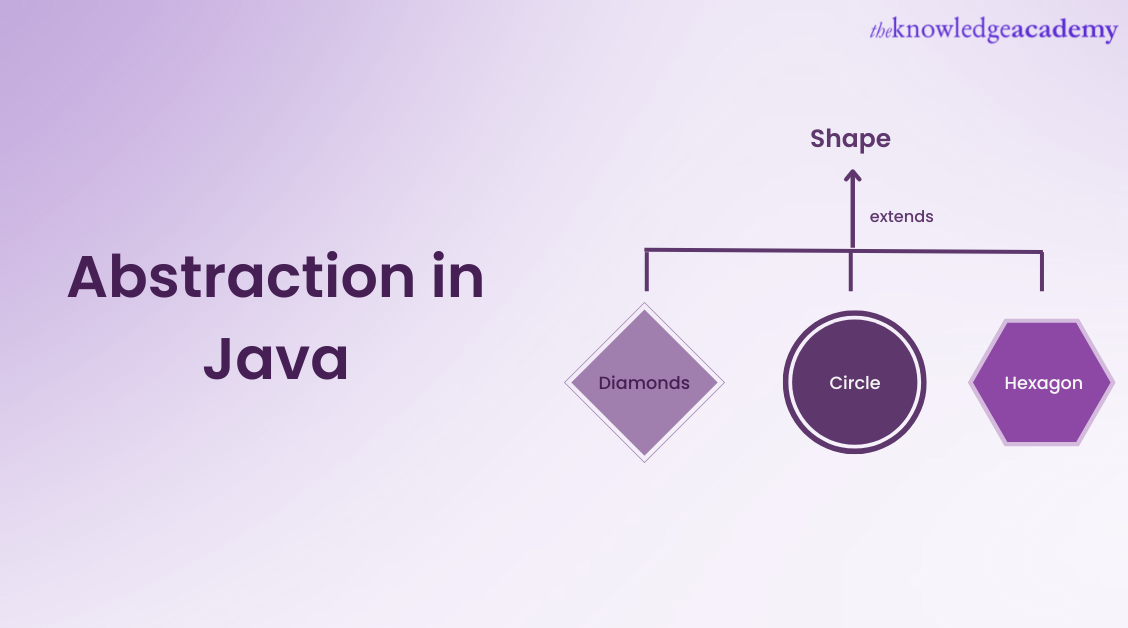We may not have the course you’re looking for. If you enquire or give us a call on 01344203999 and speak to our training experts, we may still be able to help with your training requirements.
Training Outcomes Within Your Budget!
We ensure quality, budget-alignment, and timely delivery by our expert instructors.

Abstraction in Java is an important concept that every Java Developer should understand to build robust and efficient software. In simple terms, Abstraction is the process of hiding the implementation details or irrelevant details and showing only the necessary information to the user. One of the most fundamental concepts in Java is Abstraction. This technique simplifies a program's complexity by providing a simpler view of the system.
According to the TIOBE index, Java is one of the most popular languages in 2023, with the biggest community of learners and contributors. The ease of learning makes Java an excellent skill to have on your resume. In this blog, you will learn about Abstraction in Java, its pros and cons and how to achieve it along with some real-life examples.
Table of Content
1) Abstraction in Java
2) Achieving Abstraction in Java
3) Advantages of Abstraction
4) Disadvantages of Abstraction
5) Real-life examples of data Abstraction in Java
6) Conclusion
Abstraction in Java
In Java programming, Abstraction allows developers to create Classes with Methods that perform certain functions without disclosing the inner workings of the code. This helps to simplify complex programs and makes it easier to maintain and update the code over time.
Java Abstract Classes and Java Abstract Methods
An Abstract Class is a type of class that has the abstract keyword in its declaration. It can have both abstract and concrete methods. An Abstract Method is a method that has no body and only a signature. An Abstract Class cannot have all abstract methods; some of them can be implemented. A subclass that inherits from an abstract class must override all the abstract methods or be declared as abstract itself.
A class that has any Abstract Method must be an Abstract Class. An abstract class cannot be created as an object with the new operator. It can have constructors with parameters and a default constructor.

Achieving Abstraction in Java
Java provides both Abstract classes and Interfaces to achieve Data Abstraction. Interfaces allow for complete Abstraction and maximum flexibility. It means that the implementation details are entirely hidden and abstracted from the user interface, and this approach permits maximum reusability and flexibility.
Abstract classes in Java offer partial to complete Abstraction. It can contain both concrete methods (with implementation) and abstract methods (without implementation). This approach can be helpful in scenarios where some implementation details can be shared among different subclasses.
Steps to implement Abstraction in Java
Java Abstraction is a technique that hides the unnecessary details and complexity of a system and exposes only the essential features and functionality. To achieve Abstraction in Java, you need to follow these steps:
1) Identify the classes or interfaces that share common behaviours and properties.
2) Create an Abstract Class or interface that specifies the common behaviours and properties of these classes.
3) Declare Abstract Methods within the Abstract Class or interface that have no body and must be implemented by the subclasses or implementing classes.
4) Define concrete classes that inherit from the Abstract Class or implement the interface.
5) Provide the specific implementations of the Abstract Methods in the concrete classes.
6) Use the concrete classes to execute the program logic.
Steps to implement Abstraction in Java
Java Abstraction is a technique that hides the unnecessary details and complexity of a system and exposes only the essential features and functionality. To achieve Abstraction in Java, you need to follow these steps:
1) Identify the classes or interfaces that share common behaviours and properties.
2) Create an Abstract Class or interface that specifies the common behaviours and properties of these classes.
3) Declare Abstract Methods within the Abstract Class or interface that have no body and must be implemented by the subclasses or implementing classes.
4) Define concrete classes that inherit from the Abstract Class or implement the interface.
5) Provide the specific implementations of the Abstract Methods in the concrete classes.
6) Use the concrete classes to execute the program logic.
Advantages of Abstraction
Abstraction is an important feature of Object-Oriented Programming. It is implemented though abstract classes and interfaces. Here are some advantages of Abstraction in Java:
1) Simplifies the complexity of code by hiding the implementation details
2) Provides a way to separate interface from implementation
3) Makes code easier to update and maintain
4) Improves code reusability and readability
5) Provides a clear and concise view of the system architecture
6) Facilitates easier testing and debugging of the code
7) Helps in enforcing guidelines and coding standards
8) Allows for platform independence and cross-language compatibility
9) Provides a way to represent complex real-world entities in a simplified manner
10) Allows for polymorphism and inheritance
11) Allows for code extensibility without modifying the existing code
12) Encourages modular programming and component-based development
13) Provides a way to encapsulate and modularise code
14) Provides a way to hide sensitive information from the end-user
15) Helps in reducing the coupling between components
Become a Java expert with our Java Engineer Training – Sign up today!
Disadvantages of Abstraction
Besides being so important and seen as an advantageous technique, there are also some disadvantages that come in the bucket. The following are some disadvantages of Abstraction in Java:
1) Abstraction in Java can increase complexity, particularly in dealing with complex software systems or larger codebases.
2) It can make it more difficult for developers to understand how different components of the system interact with each other.
3) All software does not require Abstraction, as sometimes it is more straightforward to write code without Abstraction.
4) Sometimes developers create too many layers of Abstraction that lead to a loss of clarity, making it difficult to maintain and even understand it.
5) If the Abstraction is poorly designed, it increases the development time leading to increased costs and delays in delivering the software.
6) If the Abstraction is used too much in any code, it can reduce performance.
Understand the concepts of Java Beans, controller helpers and reorganised controllers with our Web Development Using Java Training course today!
Real-life examples of data Abstraction in Java
Following are some examples of data Abstraction in Java:
1) Banking system: Abstraction in the banking system can be achieved by using a set of already designed functions that allow users to interact with the system without knowing how it works internally. Let’s suppose a user wants to deposit some money; they do not need to know how the transactions at the backend get processed or how the bank stores the data. They simply need to call the deposit function. Further, the banker will handle all the details behind the scenes.
2) Car rental services: Similarly, in a car rental system, the person renting a car does not need to know how the rental cars are calculated or how the inventory is managed. Sometimes they do not even need to know who owns the car. They simply need to call the rent function or agencies, which take care of all the details behind the scenes.
3) Social media platform: In a social media platform like Facebook or Twitter, Abstraction is achieved by providing users with predefined functions that allow them to interact with the platform without knowing how it works internally. For example, when users want to post something on their wall, they do not need to know how the texts or pictures are stored or how the notifications are generated. They simply need to call the post function, which handles all the details behind the scenes. Similarly, when a user wants to like, comment, or share a post, they do not need to know how those actions are moved internally. They simply need to call the corresponding functions, which take care of everything internally.

Conclusion
Abstraction in Java is an important programming concept that allows developers to design efficient software systems. It helps Programmers create simplified models of complex real-world systems and allows them to focus on essential features while hiding implementation details.
Java offers several ways for implementing Abstractions, such as Abstract Classes and Interfaces, which provide developers with powerful tools for building modular and extensible software applications. Java Developers can write more reliable, scalable, and reusable code with a solid understanding of Abstraction, leading to better software development outcomes.
Initiate your journey to learn all fundamental concepts of advanced Java; sign up for our Introduction To Java EE Training Course now!
Frequently Asked Questions

Declaring an abstract class in Java involves using the 'abstract' keyword before the 'class' keyword. This signifies that the class cannot be instantiated directly and may contain Abstract methods, which must be implemented by any concrete subclass.

Abstraction is crucial in programming because it simplifies complex systems by focusing on essential details while hiding unnecessary complexity. It enhances code reusability, maintainability, and scalability, enabling Developers to create efficient and organised software systems.

The Knowledge Academy takes global learning to new heights, offering over 30,000 online courses across 490+ locations in 220 countries. This expansive reach ensures accessibility and convenience for learners worldwide.
Alongside our diverse Online Course Catalogue, encompassing 17 major categories, we go the extra mile by providing a plethora of free educational Online Resources like News updates, Blogs, videos, webinars, and interview questions. Tailoring learning experiences further, professionals can maximise value with customisable Course Bundles of TKA.

The Knowledge Academy’s Knowledge Pass, a prepaid voucher, adds another layer of flexibility, allowing course bookings over a 12-month period. Join us on a journey where education knows no bounds.

The Knowledge Academy offers various Java Courses, including Java Programming Course, JavaScript for Beginners and Java Engineer Training. These courses cater to different skill levels, providing comprehensive insights into Latest Java Technologies Trends.
Our Java blogs cover a range of topics related to Java, offering valuable resources, best practices, and industry insights. Whether you are a beginner or looking to advance your Java Programming skills, The Knowledge Academy's diverse courses and informative blogs have you covered.







 Top Rated Course
Top Rated Course



 If you wish to make any changes to your course, please
If you wish to make any changes to your course, please


